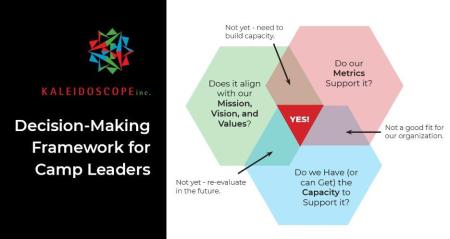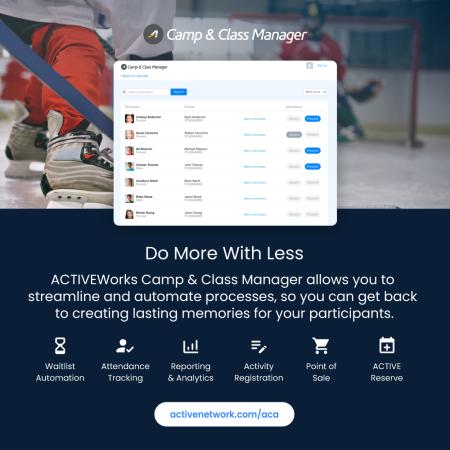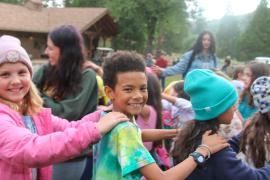Enjoy one of camp’s sweetest sounds as you walk up on a dining hall or an evening campfire and hear a chorus of voices singing a favorite camp song — 100 campers, 250 campers, 500 campers — can you imagine? Every bed is filled. All activity areas are at capacity. Everyone is happy. If you close your eyes, you can see it, hear it, almost taste it — the joy of more campers impacted by life-changing days at camp.
Camp leaders excel at telling the story of camp and sharing their passion and dreams of welcoming more campers and growing their program. The path from their vision to reality is a matter of strategy. In envisioning growth for camp, the considerations and complexities are numerous. There are lots and lots of choices. How do we tell the story to invite more families? How aggressively do we budget? Can we afford a new program?
Opinionation is a trivia-style game we enjoy most weeks at a local brewery in our town. As with the television game show Family Feud, our team of four to five deliberates our best guesses to very important questions like this recent one: “Which American President would be the most useful to have around at a family camp?” The top five answers were:
- Theodore Roosevelt
- Abraham Lincoln
- Dwight D. Eisenhower
- George Washington
- Jimmy Carter
The most assured or passionate voice, the team member who is best connected to current events, argues why their wisdom is correct — then we wait to see if the pretested audience agrees. Does the pattern sound familiar? From each lens of experience (in person, through a social media site, camper’s input, or seasonal staff opinion), your staff stakes claim and deliberates their best guesses on how to spur camp growth in the next year.
Growth strategy doesn’t have to be a guess. Thriving camps consistently use a strong decision-making framework as a part of their strategy. The framework will provide alignment with the camp’s mission, vision, and values as it supports relevant metrics and the available capacity for implementation.
Consistency with Mission
The camp’s mission, vision, and values serve as its guiding principles. Before making any significant decisions, camp leaders must evaluate whether the proposed action aligns with these fundamental ideals. This alignment ensures that the camp remains true to its core purpose and continues to provide an experience in line with its founding principles.
Ethical and Moral Considerations
Beyond the written mission and values, leaders should also consider the ethical and moral implications of their decisions. Does the proposed change or action reflect the camp’s commitment to inclusivity, environmental sustainability, or community building? Ensure that decisions uphold the camp’s moral compass.
Stakeholder Involvement
Decision-makers should engage with key stakeholders, including camp staff, campers, parents, and the local community. Their input is invaluable in assessing whether a decision aligns with the camp’s broader goals and is seen positively by those it impacts.
Do Our Metrics Support It?
You must consider a host of metrics to know whether or not your organization can support the strategic decision you’re considering.
Comprehensive Metrics
When considering a decision, leaders must evaluate whether their existing metrics and key performance indicators support it. Metrics should offer a comprehensive view of the situation, capturing the entire picture rather than focusing on isolated data points.
Forward-Looking Metrics
Effective metrics should not merely provide a snapshot of the current situation but also anticipate future needs and challenges. A decision that aligns with forward-looking metrics is more likely to be sustainable in the long term.
Repeatable Metrics
Metrics should be repeatable and consistent over time. This enables camp leaders to make accurate comparisons and track the success or impact of their decisions. Without reliable data, it is challenging to assess the effectiveness of any action.
Do We Have (or Can We Get) the Capacity to Support It?
Knowing if you have the capacity to implement a decision means looking at available staff, financial resources, and the overall level of commitment to the change.
Staffing
Decisions often require the support of a capable workforce. Leaders must assess whether they have the necessary staff or can acquire the talent needed to execute the decision successfully. A lack of staffing can lead to a decision’s failure or strain existing resources.
Funding
Adequate funding is crucial for many camp decisions, especially those involving significant investments. Camp leaders must determine whether they have the financial resources to support the decision and, if not, explore funding options. This could involve grants, sponsorships, or fundraising.
Commitment
Finally, it’s essential to consider whether the organization has the capacity to commit to the decision. Do staff have adequate capacity to give their time and talent to making it successful? Can a choice be supported and messaged in such a way that campers, parents, and the broader community will appreciate and engage with the change?
Viewing through only one lens is a guess. Discernment through multiple lenses is a strategic decision. The plethora of considerations and opinions doesn’t have to strangle a leadership team or leave you making guesses about how to live into the vision of increasing impact — deeper experiences with more campers, year after year. Strategic decisions within a framework allow leaders to confidently lead.

Jody Oates is the president and principal consultant with KALEIDOSCOPE, inc., a nationally known planning and consulting firm that works with camps as well as retreat and outdoor centers to help them thrive. He provided visionary and strategic leadership as the executive director of camp and retreat centers and also with KALEIDOSCOPE, working with many shapes, sizes, and styles of outdoor centers across the country.
Ryan Moore is a consultant with KALEIDOSCOPE, inc., serving camps and retreat centers of all sizes. Ryan has great skill in analysis and strategic leadership, working well with groups to envision potential models and opportunities for the future. Ryan served camps in South Carolina, Montana, Texas, and Tennessee prior to joining Kaleidoscope full time.



